Thank you for visiting! By the way… any links on this page that lead to products on Amazon and other stores/partners are affiliate links Aquarium Store Depot earns a commission if you make a purchase.
Gouramis have a calm and peaceful nature. They are beautiful fish with little care that needs no introduction in the aquarium hobby.
The Dwarf Gourami is known scientifically as Colisa lalia1. It is indigenous to Pakistan, Bangladesh, Borneo, Myanmar, and Nepal. It may thrive in flooded rice fields and is found in slow-moving streams, lakes, and tributaries of the Ganges and Brahmaputra rivers.
As long as Dwarf Gouramis are kept with fish of similar temperaments and tank size, they function well in community tanks.
Gouramis are aggressive toward other gouramis despite their timid nature, especially the male gouramis. Therefore, they need ample hiding places. Every gourami builds its area and hiding spot. They prefer heavily planted tanks with a minimum tank size of 10 gallons. I also advise adding floating plants to the gourami tank so they have enough room to hide.
Key Takeaways
- Choose suitable tank mates for Dwarf Gouramis so they can live in harmony
- Dwarf gouramis are a type of labyrinth fish that have a special organ that allows them to take in oxygen from the surface of the tank
- Since dwarf gouramis are calm fish, they may be kept in community tanks. However, you should be aware that certain fish species may end up harassing the dwarf gourami.
How To Choose Tank Mates
Choosing suitable tank mates for Dwarf Gouramis is very important. Since they can get aggressive at times, make sure the tank mates you choose complement the Gourami tank.
There are a few parameters you need to consider before choosing the right tank mate for your Dwarf gouramis.
Water Parameters
- Water Temperature: 75-82°F
- pH: 5.5 – 7.0
- Hardness: 50—150 ppm
- Water flow: Low
- Tank size: 20 gallons +
Since Dwarf Gourami is a tropical fish, they require high temperatures to thrice. The ideal temperature range of 75-82°F is preferred.
Nitrite and ammonia should test negative at 0 ppm. Any type of nitrogenous waste is bad for dwarf gouramis; even nitrate levels need to be carefully watched. The dwarf gouramis prefer slightly acidic water with a pH of 5.5 – 7.0. Stress will be reduced to levels of 10 ppm or less nitrate. To ensure that a fresh aquarium is properly cycled, add dwarf gouramis last to a new aquarium.
Temperament
Tank mates for dwarf gourami should be docile and social fish species of comparable size. Male dwarf gourami may occasionally display semi-aggressive behavior against other fish. However, they lack the aggression to kill them.
When no female gouramis are around, male gouramis frequently exhibit aggressive behavior. When your male gourami is trying to win over a female, his colors will likewise be more vibrant.

Tetras, rasboras, danios, and cherry barbs are a few examples of shy, soft water aquarium fish that make suitable tank mates. Semi-aggressive species like dwarf cichlids, pea puffers, betta fish, and angelfish are also good for bigger aquariums (40+ gallons).
Size
Dwarf Gourami does well in community tanks that are 20 gallons in size or larger. They need a serene, peaceful setting.
Therefore, avoid placing your aquarium in a busy area if you intend to keep them there. You should also note that the aquarium shouldn’t receive any direct sunlight. There shouldn’t be much movement in the water, and the lighting should be minimal.
Honey Gourami vs Dwarf Gourami
Both the honey and the dwarf gourami are beautiful fish species with amazing traits and appearances. Each fish has a unique set of characteristics. If you have trouble deciding which one to get, I’ll list down some important pointers in this section.
Read on.
Appearance and Size
Dwarf gourami and honey dwarf gourami have drastically distinct appearances.
Firstly, when male honey gourami becomes adult and more mature, they start to display vivid yellow, orange, red, and golden colors.
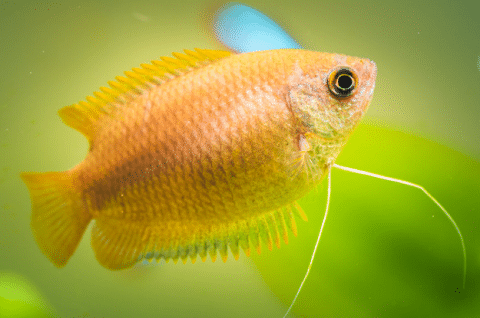
Comparatively, females have more silver and grey coloring. Since the fins of both sexes frequently resemble each other and male honey gouramis only later tend to develop vivid, distinguishing colors, it can occasionally be challenging to seduce juvenile honey gouramis.
Female honey gouramis grow to a maximum of 2 inches, although males often reach 1.5 inches.
Temperament
As far as temperament is concerned, dwarf gouramis are considered semi-aggressive fish at times, especially with other male gouramis. Whereas honey gouramis are more peaceful fish, ideal for beginners for a community tank.
It is believed that in a community tank where any fish shows the slightest of aggressive behavior, honey gouramis will hide and feel intimidated by them
Color Variety
In terms of color variety and overall beauty, honey gouramis cannot compete with dwarf gouramis.
Blue, orange, rainbow, and red are just a few of the many hues that dwarf gouramis may have. Dwarf gouramis typically have several colors, which gives them a more appealing appearance than honey gouramis.
Males and females both have bright patterns, while females are often more silvery. Because male dwarf gouramis tend to be leaner and shorter and females have a rounder abdomen and a smaller dorsal fin, sexing dwarf gouramis is not difficult.
Since dwarf gouramis may reach lengths of up to 4.5 inches, they are larger than honey gouramis and need a larger aquarium.
Top 15 Aquarium Companions
Now that you know how to choose the ideal tank mates for your dwarf Gouramis and whether honey gouramis or dwarf gouramis are better for you.
Let’s take a look at my favorite list of 15 Dwarf Gouramis tank mates.
1. Corydoras Catfish
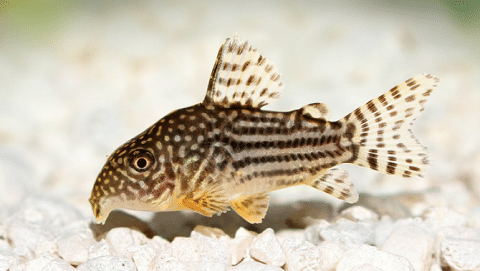
- Scientific Name”: Corydoras
- Adult Size: 2.5 to 12 cm (1.0 to 4.7 in)
- pH: 6.5 to 7.8
- Water Temperature: 72 and 82°F.
- Minimum Tank Size: 20 gallons
- Safe With Dwarf gourami Fry? Yes
- Recommended School Size: Group of 5 or more
The Corydoras catfish species are well-known across North America. There are over 150 identified species, which are dispersed worldwide.
Corydoras catfish are excellent for maintaining in aquariums with other fish of the same type. They coexist quietly and never bother the other fish in the tank. They assist in cleaning the debris and extra food that has been collected at the bottom of the aquarium as they continue to forage for food there.
As they would join a group with other Corydoras, they are regarded as “social” in the aquarium. Together, they will swim, look for food, and even take breaks. One catfish will often be perched on top of another. They will make friends with other tank mates and live contentedly even if there are no catfish around. In the aquarium, you must keep them together or at least with other fish species of the same kind.
2. Harlequin Rasboras
A peaceful schooling fish. An ideal community fish. A great beginner fish
- Scientific Name”: Trigonostigma heteromorpha
- Adult Size: 2 inches
- pH: 6.0 to 7.5
- Water Temperature: 72 and 81°F.
- Minimum Tank Size: 10 gallons
- Safe With Dwarf gourami Fry? Yes
- Recommended School Size: Group of 8 to 10
As a schooling fish, the Harlequin Rasbora should be kept in a reasonable-sized group. A group of twelve Harlequin Rasboras in a fish aquarium is a stunning and lovely sight. Despite being an Asian fish of a different species, it has many traits with little tetras from South America.
The Harlequin Rasbora is a perfect fish for a community tank with adorable little fish, but I would steer clear of large or aggressive species. Lemon, Neon, Cardinal, Emperor, Head and Tail, Glowlight, Corydoras Catfish, White Cloud Mountain Minnows, Dwarf Gourami, Zebra Danios, and other small fish species are examples of companion fish that are suitable for Harlequin Rasboras.
3. Bristlenose Pleco
The Bristlenose Pleco is a smaller Pleco that does a great job of eating algae. Peaceful and gets along with most fish
- Scientific Name: Ancistrus cirrhosus
- Adult Size: 4 to 5 inches
- pH: 6.5 to 7.5
- Water Temperature: 73 and 80°F.
- Minimum Tank Size: 20 to 30 gallons
- Safe With Dwarf gourami Fry? Yes
- Recommended School Size: Group of 2 to 3
Because they are the smaller version of the common pleco, bristlenose plecos are frequently preferable for smaller aquariums with like-minded fish species. They can only reach a maximum size of around 5 inches, which is rather comparable to the dwarf gouramis.
The fact that Bristlenose plecos are nice and peaceful fish makes them ideal tank mates for dwarf gourami species. They have a five-year lifespan.
The majority of their food is herbivore, which is something to keep in mind, but because dwarf gouramis are omnivores, this shouldn’t be too much of an issue. Because they like to hide and swim between barriers in the tank, bristlenose plecos require a sufficient amount of plants and hiding spots.
4. Cherry Barb
- Scientific Name: Puntius titteya
- Adult Size: 2 inches
- pH: 6 to 8
- Water Temperature: 73 and 81°F.
- Minimum Tank Size: 25 to 30 gallons
- Safe With Dwarf gourami Fry? Yes
- Recommended School Size: Group of 5 or more
Compared to other barbs, the Cherry Barb (Puntius titteya) is a considerably more calm fish. It originates in Sri Lanka (which used to be called Ceylon). It is uncommon in its natural environment, where habitat degradation is a danger. It is a quiet and well-liked, peaceful community fish (schooling fish).
Cherry Barbs are omnivores, like the Gourami fish. In the wild, they will consume algae, insect larvae, particularly young mosquitoes, and a variety of other little things. They are simple fish to feed and will consume any typical fish food in the tank. All these factors make them good tank mates for Dwarf Gourami.
They like the occasional feeding of live food, such as daphnia or wrigglers, like almost other aquarium fish do. Frozen blood worms, for example, are a tasty delicacy.
5. Neon Tetra
Use Promo Code ASDFLIPPROMO
One of the most popular freshwater community schooling fish available in the aquarium trade. Great neon blue colors!
- Scientific Name: Paracheirodon innesi
- Adult Size: 4 inches
- pH: 6 to 8
- Water Temperature: 72 and 76°F.
- Minimum Tank Size: 10 gallons
- Safe With Dwarf gourami Fry? Yes
- Recommended School Size: Group of 6 or more
One of the most popular aquarium fish is the Neon Tetra or Paracheirodon innesi. It can grow to a maximum length of a little over 3cm. Neon Tetras are suitable for an aquarium with other small fish in it.
Small Rasboras, tiny tetras, and livebearers like platies, swordtails, and guppies are some fish species that can be excellent tank mates for them.
There should be Plants or other covering present in the community tanks. This gives the fish some security and also, these fish species reveal more of themselves around plants.
Since the neon fish schools are in groups of four or more, I advise keeping them in groups. Additionally, a group of neon Tetra fish in an aquarium is a stunning sight. The Neon’s colors fade in the dark but immediately return when it is illuminated.
Neon Tetra fish feeds on all typical aquarium diets, including flakes. They also benefit from eating dry fried food.
6. Cardinal Tetra
A very popular schooling fish. Looks like the Neon Tetra, but with longer blue and red stripes. Grows larger than a neon tetra as well
- Scientific Name: Paracheirodon axelrodi
- Adult Size: 1.25 inches
- pH: 4.6 to 6.2 range
- Water Temperature: 73°F to 81°F
- Minimum Tank Size: 10 gallons
- Safe With Dwarf gourami Fry? Yes
- Recommended School Size: Group of at least 6 or more
The Cardinal Tetra originates from the upper Amazon River. Both the environment and the fish are tropical. Unless they can be housed in an environment that never gets chilly, cardinals need hot water. An aquarium heater is a logical choice for heating the water. I advise adjusting the temperature to 24C for Cardinals.
Cardinal Tetra and Dwarf Gourami are frequently successfully housed, and they appear to be better able to withstand high temperatures. Dwarf Gourami requires different care than neon fish. Additionally, they are slightly larger than Dwarf Gouramis and are less prone to be eaten by them.
All large, aggressive fish, Buenos Aires Tetras, and Tiger Barbs are not advisable to keep with Cardinals. There is a considerable risk if you do that, but I am aware of examples where people have successfully kept Cardinals with some of the fish I just mentioned.
7. Black Skirt Tetra
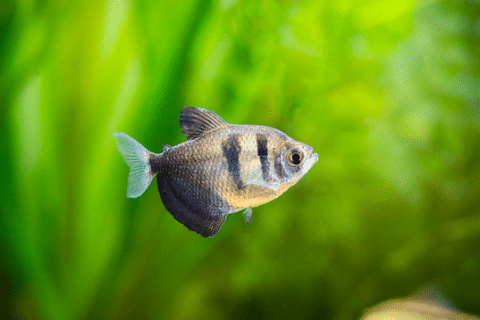
- Scientific Name: Gymnocorymbus ternetzi
- Adult Size: 3 inches
- pH: 6.0 – 7.5
- Water Temperature: 78°F – 82°F
- Minimum Tank Size: 15 gallons
- Safe With Dwarf gourami Fry? Yes
- Recommended School Size: Group of at least 6 or more
Black Skirt Tetras are calm, peaceful fish species. As long as no other fish in the community are particularly hostile, they are peaceful schooling fish and thrive in community fish tanks.
The fish swim in teams. As a result, adding many tetras with other tank mates like the Dwarf Gourami to your community tank is a smart idea. The ideal range is four to six.
8. Molly Fish

- Scientific Name: Poecilia sphenops
- Adult Size: 3½ to 6 inches
- pH: 7.5 – 8.5
- Water Temperature: 75°-80°F
- Minimum Tank Size: 10 gallons
- Safe With Dwarf gourami Fry? Yes
- Recommended School Size: Group of at least 4
Mollies are fish that dwells on the surface and are active. They are available in practically all live fish shops. There are a variety of captive-bred species that can adapt to a variety of water characteristics. Mollies and dwarf gourami can be kept together even though they both prefer harsher water.
Mollies may also be fairly aggressive when it comes to eating and are extremely swift. They are such chowhounds that it might be challenging for slower fish to reach food quickly enough, not because they intentionally hurt other fish when they are feeding.
To give the gourami fish a greater opportunity of snatching a meal away from the voracious mollies, you might want to think about putting food in more than one location.
9. Chili Rasbora
Use Promo Code ASDFLIPPROMO
A great nano schooling fish. Males display brighter colors. Best in groups of 6 or more
- Scientific Name: Boraras brigittae
- Adult Size: 0.7 inches
- pH: 4.0-7.0
- Water Temperature: 68 – 82.4° F
- Minimum Tank Size: 5 gallons
- Safe With Dwarf gourami Fry? Yes
- Recommended School Size: Group of at least 6 or more
Chili Rasboras are small fish with thin bodies. Although they are very peaceful fish and require a group of at least 10 fish to school, this species is exceptionally appealing. These fish’s crimson hue contrasts beautifully with powder blue dwarf gouramis.
Dwarf Gouramis and Chili Rasboras require the same sort of water. Therefore, they go along perfectly. The origin of this fish is Southeast Asia, which explains why their requirements for conditions are so similar.
10. Zebra Danios
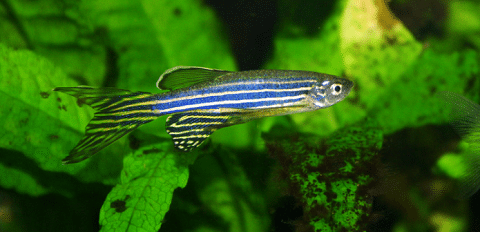
- Scientific Name: Danio rerio
- Adult Size: 1.5 inches
- pH: 7.0 to 7.8
- Water Temperature: 64 – 75 °F
- Minimum Tank Size: 5 gallons
- Safe With Dwarf gourami Fry? Yes
- Recommended School Size: Group of at least 6 or more
The Zebra Danio fish are small fish that only gets to be approximately 2 inches (5 cm) long. Although it is mostly calm, I have seen enough aggressiveness to classify it as mildly hostile as opposed to serene.
It is a schooling fish that is more prone to act aggressively when there are fewer tank mates.
The Siamese Fighting Fish has been known to be attacked by a school of Zebra Fish, therefore, I would stay away from slow-moving fish with long fins around Zebra Fish.
White Cloud Mountain Minnows, the majority of tetras, including Neon Tetras, Cardinal Tetras, Glass Bloodfin Tetras, Emperor Tetras, Black Widow Tetras, tiny Goldfish, Dwarf Gourami, and other fish species of comparable size are all good tank mates for zebrafish.
11. Rainbowfish

- Scientific Name: Melanotaeniidae
- Adult Size: 4.7 inches
- pH: 7.0 to 8.0
- Water Temperature: 74° and 78° F
- Minimum Tank Size: 30 gallons
- Safe With Dwarf gourami Fry? Yes
- Recommended School Size: Group of at least 6
There is a solid reason why rainbow fish are adored in the aquarium hobby all around the world. These fish are serene and lovely. They are freshwater fish that have their roots in Southeast Asia and Australia.
Rainbow tropical fish are not only attractive, but they also get along well with many different aquarium freshwater fish species.
Finding tropical freshwater fish that get along with rainbow fish is frequently a challenge; even tetras have a reputation for occasionally biting fins. Guppies, angel fish, rasboras, and loaches are some other fish that are similarly unconcerned. They are incredibly patient creatures who are also rather hardy, which makes them a good tank mate for Dwarf Gourami as well.
12. Otocinclus Catfish
A small algae-eating fish. Also great with freshwater shrimp.
- Scientific Name: Otocinclus
- Adult Size: 1 1/2 – 2 inches
- pH: 6-7.5
- Water Temperature: 72-82°F
- Minimum Tank Size: 10 gallons
- Safe With Dwarf gourami Fry? Yes
- Recommended School Size: Group of at least 6
The Dwarf Suckermouth Catfish, also known as the Otocinclus Catfish, is one of the most popular algae-eating fish for small aquariums, but they do have certain possible issues that are important to be aware of before purchasing.
At first, they might be challenging to keep as they are captured from the wild. Unfortunately, pet shops and distributors frequently treat them poorly. The poor tiny oto cats are underfed and may be nearly dead by the time they reach a display tank in a store.
The active and healthy Oto cats must be kept in groups of at least five.
13. Kuhli Loach
Kuhli Loaches are hardy bottom-dwelling fish. Nocturnal in nature. Gets along with many fish and tolerate of coldwater environments
The Kuhli loach belongs to the family Cobitidae. They are also known as Pangio kuhli or Acanthophthalmus kuhli. Kuhli loach are native to Indonesia. You can also find them in Singapore, Malaysia, Borneo, and Java.
The bodies of kuhli loaches are long and eel-like without scales. They frequently have bands down the length of their bodies that alternate between light and dark colors. They resemble a snake more than a fish because of the way the form and color bands combine. Kuhli loach is a bottom dweller and unquestionably one of the aquarium’s most intriguing additions.
14. Glass Catfish (Ghost Fish)

- Scientific Name: Kryptopterus vitreolus
- Adult Size: 3.1 inches
- pH: 6.6 – 7.5
- Water Temperature: 77°F
- Minimum Tank Size: 30 gallons
- Safe With Dwarf gourami Fry? Yes
- Recommended School Size: Group of at least 5 or more
Even though Glass Catfish is mainly a predator, it goes along with other fish as long as they are not in its very small mouth. While any reasonably sized adult fish, including tiny Neon Tetras, Cardinal Tetras, Green Neon Tetras, and Dwarf Gourami are safe, they will undoubtedly consume newborn fish.
Others that make good aquarium mates are Diamond Tetras, Splashing Tetras, White Cloud Mountain Minnows, Cherry Barbs, Penguin Tetras, Pristella Tetras, Glowlight Tetras, Red Eye Tetras, Silvertip Tetras, Gold Barbs, Rummy Nose Tetras, Scissortail Rasboras, Emperor Tetras, Head and Tail Light Tetras, Glass Bloodfin Tetras, Swordtails.
15. Amano Shrimp
Best For Planted Tanks!
When it comes to keeping a healthy planted aquarium, Amano Shrimp are the best. These hard-working crustaceans will dutifully wipe your plants and rockwork clean of algae. Their appetite for different types of algae that can't be matched by other shrimp breeds!
- Scientific Name: Caridina multidentata
- Adult Size: 2 inches
- pH: 6 to 7.5 pH
- Water Temperature: 64° to 80°F
- Minimum Tank Size: 5 gallons
- Safe With Dwarf gourami Fry? Yes
- Recommended School Size: Group of at least 5
If you’re keen on keeping shrimps in your aquarium, Amano shrimp is a good tank mate for Dwarf Gourami.
Amanos are too big to fit in a dwarf gouramis mouth. Thus, eating shrimp becomes too challenging for your Dwarf Gouramis.
Also, Amano Shrimps are really good at getting out of the way quickly if they have to.
Amanos hide a lot and they seem more aware of where they go and how they move. Additionally, dwarf gouramis don’t really hunt and attack like that so there are fewer chances of accidents.
FAQs
What fish live well with this type of fish?
Dwarf Gourami goes well with small, peaceful fish that don’t attack or bully them. Dwarf gouramis don’t become that big, as their name suggests.
They are also rather timid, even though they occasionally display aggression toward other males of the same species.
The ideal tank mates are:
Neon tetra
Cardinal tetra
Harlequin Rasbora
Glass catfish
Amano shrimp
Zebra danios
Can they live with other fish?
Yes, even though Dwarf gourami is not schooling fish, if given adequate space, certain species can be housed alongside another gourami of the same sort. They are territorial toward other Anabantoids, but if each has adequate space for a territory, they may cohabit happily.
Are they aggressive?
In contrast to the much bigger regular gourami, which may become aggressive, dwarf gouramis are mostly docile fish. Dwarf gouramis thrive in most community aquariums and get along well with most species, including Tetras, Mollies, Ghost Catfish, Platies, and Plecostomus.
Can they go in a community tank?
The dwarf gourami, a small freshwater fish with vivid colors, is a great addition to the community tank. The dwarf gourami is the ideal community fish if you want a fish that gets along well with other peaceful species.
How many gouramis should be together?
Dwarf Gourami is not schooling fish but thrives in a community of at least ten other fish. As a result, trying to keep them in a smaller tank prevents them from having enough space to swim around and learn. They need some open swimming places but will happily weave in and out of heavily planted regions.
Are they good with other fish?
Yes, Dwarf Gourami are good with many fish species such as Neon Tetras, Cardinal Tetras, ghost fish, Ghost shrimp, Amano shrimp, and other suitable tank mates.
How big do they get?
Dwarf Gourami fish species may grow to a maximum length of 8.8 cm (3.5 in). In the wild, male dwarf gouramis have diagonal stripes that alternate between blue and red hues; females are silvery in appearance.
Final Thoughts
Dwarf Gouramis are docile, friendly freshwater fish that shouldn’t be kept with any larger, more aggressive fish. They also shouldn’t be housed with fish that reproduce and become territorial, such as cichlids, as these fish would pester the gourami nonstop while guarding their young.
When needed, hiding spaces will be established because they are frequently territorial among one another.
- About the Author
- Latest Posts
I’m thrilled that you found Aquarium Store Depot! Here you’ll find information on fish, aquariums, and all things aquatics related. I’m a hobbyist (being doing this since I was 11) and here to help other hobbyists thrive with their aquariums! I adhere to a high quality Editorial Process and Review products with real life field usage and practical analysis.

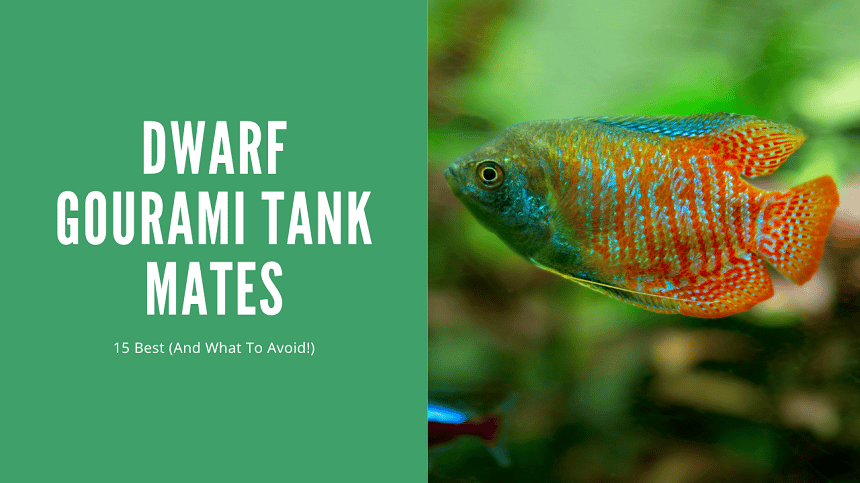


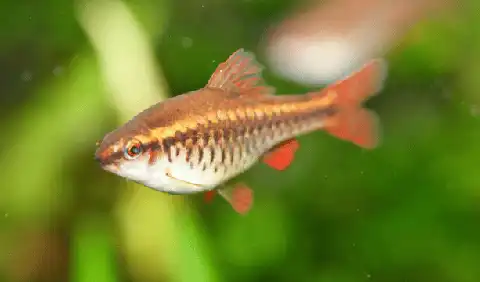
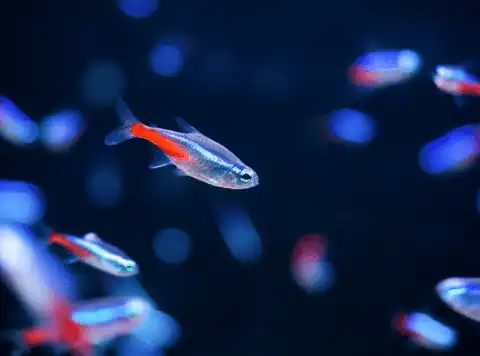
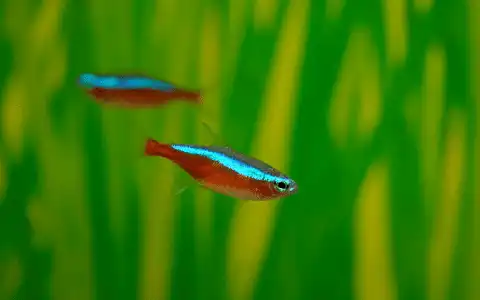

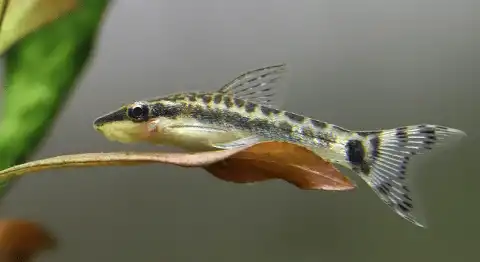






Can dwarf gouramis get along with blue pearl gouramis ?
A Pearl Gourami is best placed as the only gourami in the tank. Consider adding other fish to compliment them. Pearls are one of the most peaceful Gouramis out there and do not do well against more aggressive gouramis like the dwarf.
Hello, Very helpful info however I noticed some confliction. One paragraph says they are not a schooling fish and another says they are. I was under the impression they are not. Could you clarify?
Can they live with other fish?
Yes, even though Dwarf gourami is not schooling fish…
How many gouramis should be together?
Dwarf Gourami is a schooling fish that thrives in a community of at least ten other fish.
It’s a typo – it’s not a schooling fish. Just social